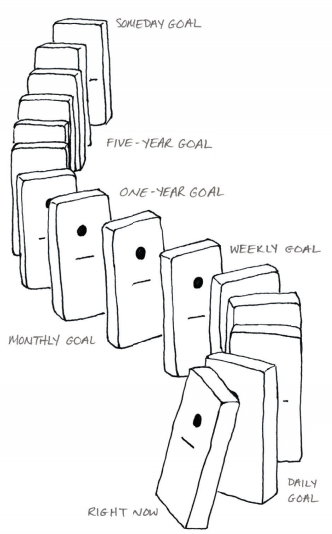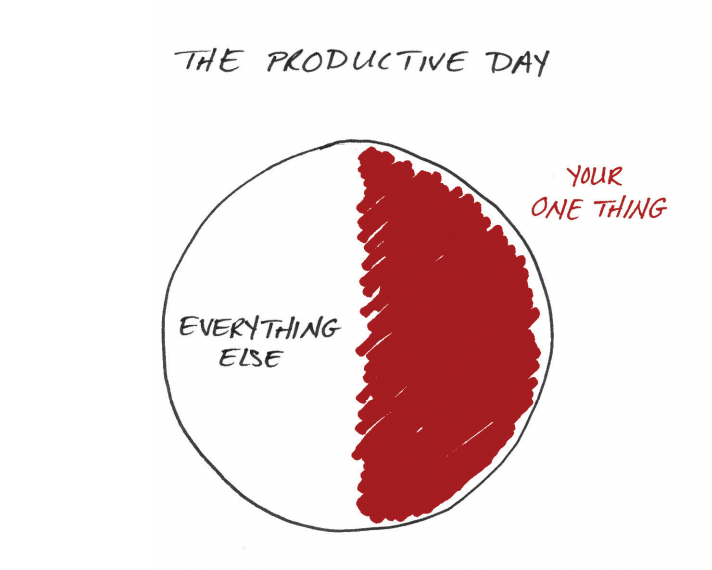Finding the Shortest Path to a Big Goal

1. Identify your long term goal
This process is about achieving a long term goal as quickly as possible. But you need to have a goal in mind.
2. Identify your one year goal
Ask yourself: “What is the ONE THING I can do THIS YEAR such that by doing it everything else will be easier or unnecessary in achieving my long term goal?” That ONE THING is your goal for the year.
3. Identify your goal for THIS MONTH
“What is the ONE THING I can do THIS MONTH such that by doing it everything else will be easier or unnecessary in achieving my one year goal?” That ONE THING is your goal for the month.
4. Identify your goal for THIS WEEK
“What is the ONE THING I can do THIS WEEK such that by doing it everything else will be easier or unnecessary in achieving my one month goal?” That ONE THING is your goal for the week.
5. Identify your goal for this TODAY
“What is the ONE THING I can do TODAY such that by doing it everything else will be easier or unnecessary in achieving my one week goal?” That ONE THING is your goal for today.
6. Work on TODAY’s goal for the first 4 hours of your day
Spend the FIRST HALF of your day working on your ONE THING. No interruptions, no distractions, no emails, no phone calls, no meetings. Just laser focused work on your most important task. Your morning is spent on your most important thing. The afternoon is left for emails, phone calls, and meetings. By working on your ONE THING first, you are sure it will get done. Things left for later have a chance of not getting done.
Meaningful Days
This process is not just about getting stuff done and being more productive: It’s about having meaningful days; being motivated and happy; working on important things that have a real impact and that truly make a difference.
Since I’ve started to use this process I’m more engaged at work, more motivated, less stressed out, and happier. I get to devote uninterrupted time to important meaningful projects that will have a huge impact. If I “run out of time” during my day, it’s the unimportant things that get dropped.
The Productive vs The Unproductive Day
Do you ever feel like you’ve been SUPER busy all day, yet didn’t get anything accomplished? Those are the days where you DID NOT work on your one most important thing.
The difference between a PRODUCTIVE day and an UNPRODUCTIVE day is how much time you spend on your ONE THING. If you work on your ONE THING first, your day is already productive and rewarding by the time lunch rolls around. It doesn’t matter what happens the rest of your day.
The Myth of Multitasking
It is a myth that you get more done by doing many things at the same time. If you want huge success, you need to be very narrowly focused. If you try to do two things at once you won’t do either well. Chasing too many rabbits leads to catching none.
“Do fewer things for more effect
instead of doing more things with side effects”
Multitasking is a form of self distraction. When switching between two tasks, there is always a reorientation phase, and that’s wasted time.

The 80 / 20 rule
Not all things matter equally. Not all tasks are created equal. You need to focus on those that matter most and that produce the biggest results: If 20% of you activities result in 80% of your results, then you should be spending more of your time on those activities.

The Importance of Only ONE Thing
There can only be one most important thing. Many things may be important, but only one can be the most important. Not a few things… Not two things… ONE THING!
What is my ONE THING?
If today you (or your company) don’t know what your ONE THING is, then your ONE THING is to figure that out.
Family, Friends, and Life Outside of Work
Following this process means spending a large amount of time focused on a single often “work” related goal. That usually means less time for your family, friends, and other priorities. It is very important to ensure you are spending quality time with your family and friends during your evenings, weekends, and vacations.
“Imagine life is a game in which you are juggling five balls. The balls are called work, family, health, friends and integrity. And you’re keeping all of these in the air. But one day you finally come to understand that work is a rubber ball. If you drop it, it will bounce back. The other four balls – family, health, friends and integrity – are made of glass. If you drop one of these, it will be irrevocably scuffed, nicked, perhaps even shattered.”
Chaos!
Following this process tends to cause some chaos. Since you have less time to do “maintenance” work, you will tend to experience a messy desk, a messy email inbox, etc… Either clean it up in the afternoon, or live with it. Those are the costs of narrow focus and great results.
“It’s not that we have too little time to do the things we need to do, it’s that we feel we need to do too many things in the time we have.”
Other Applications…
In your non-work life
The “One Thing process” can also be used at a smaller scale in your non-work life: What is the ONE thing you can do for your family that will have the most positive effect? What is the ONE thing you could do for your spouse that would make your relationship better? What is the ONE thing you could do for your parents or friends? What is the ONE thing you could change to improve your health? What is the ONE thing from a personal standpoint that would bring you the most happiness? Etc…
In your company
Your company should use this process to be laser focused on it’s most important, most impactful goal. And at a smaller scale, each department and each employee should have their long term goals with work backs to what their ONE THING for today is. If you have weekly status meetings, they should be used to help identify everyone’s ONE THING. Employee performance reviews should be about their ONE THING. Etc…
More About this Topic
If you like the One Thing as I’ve described it here, and want to learn more about it, then I highly recommend you purchase the book or visit the Official One Thing site
- THE ONE THING book on Amazon
- Official site: http://www.the1thing.com/

















